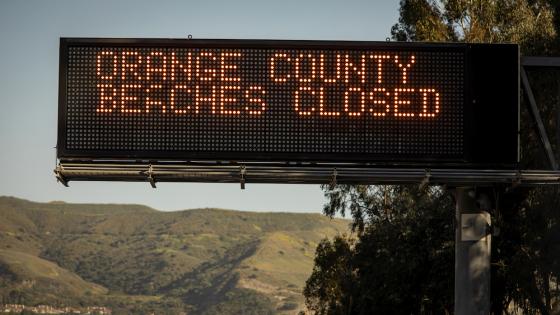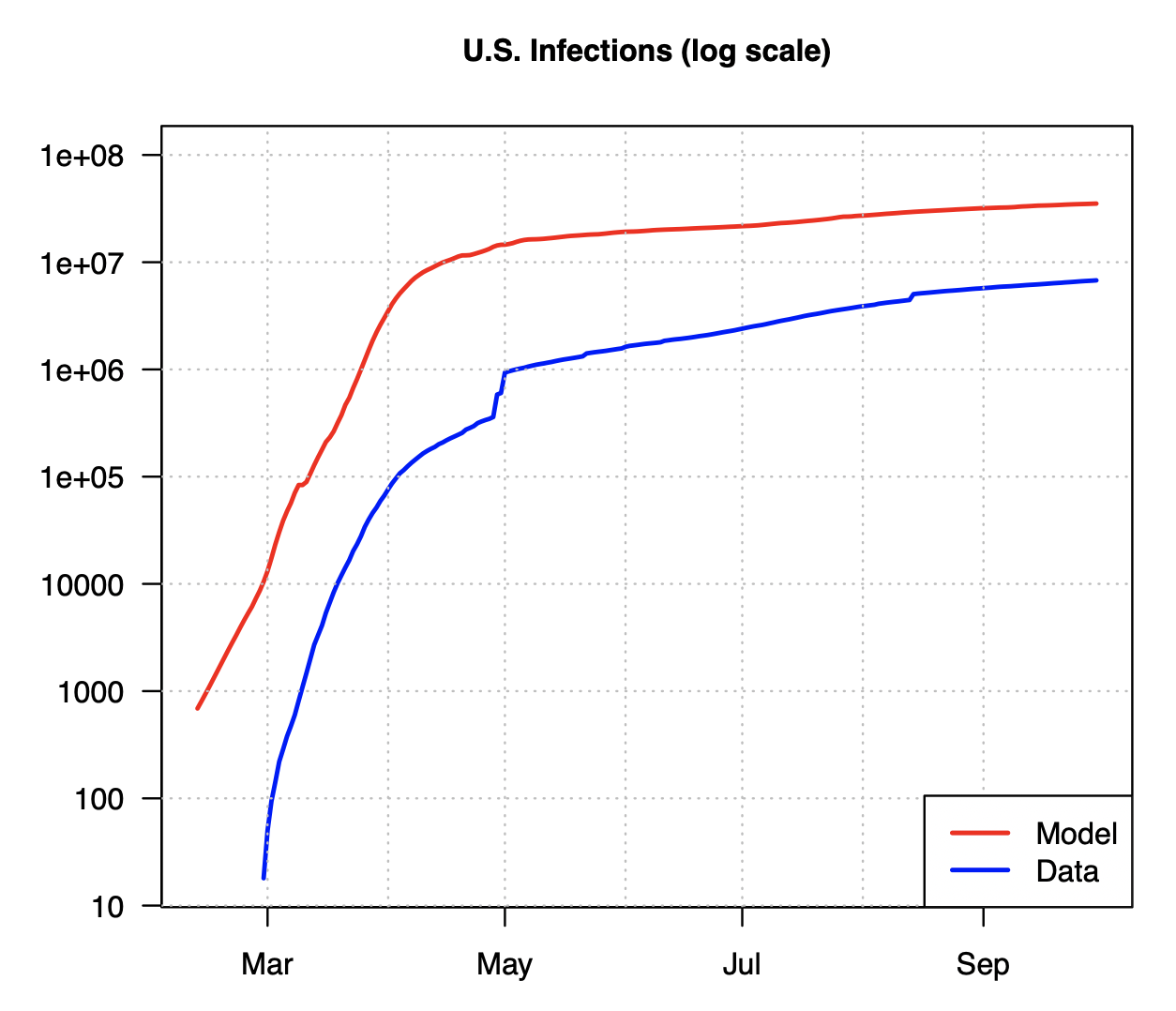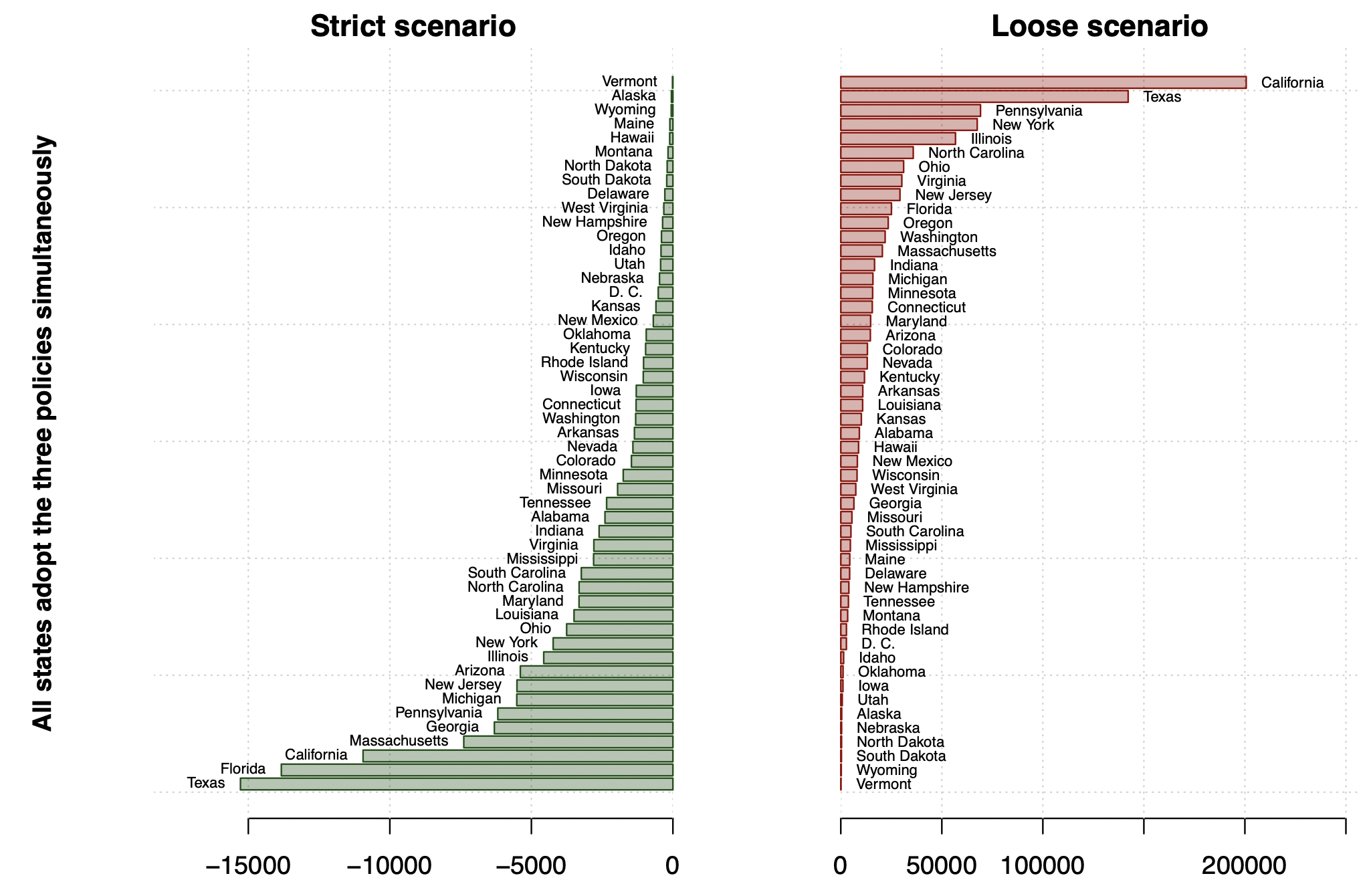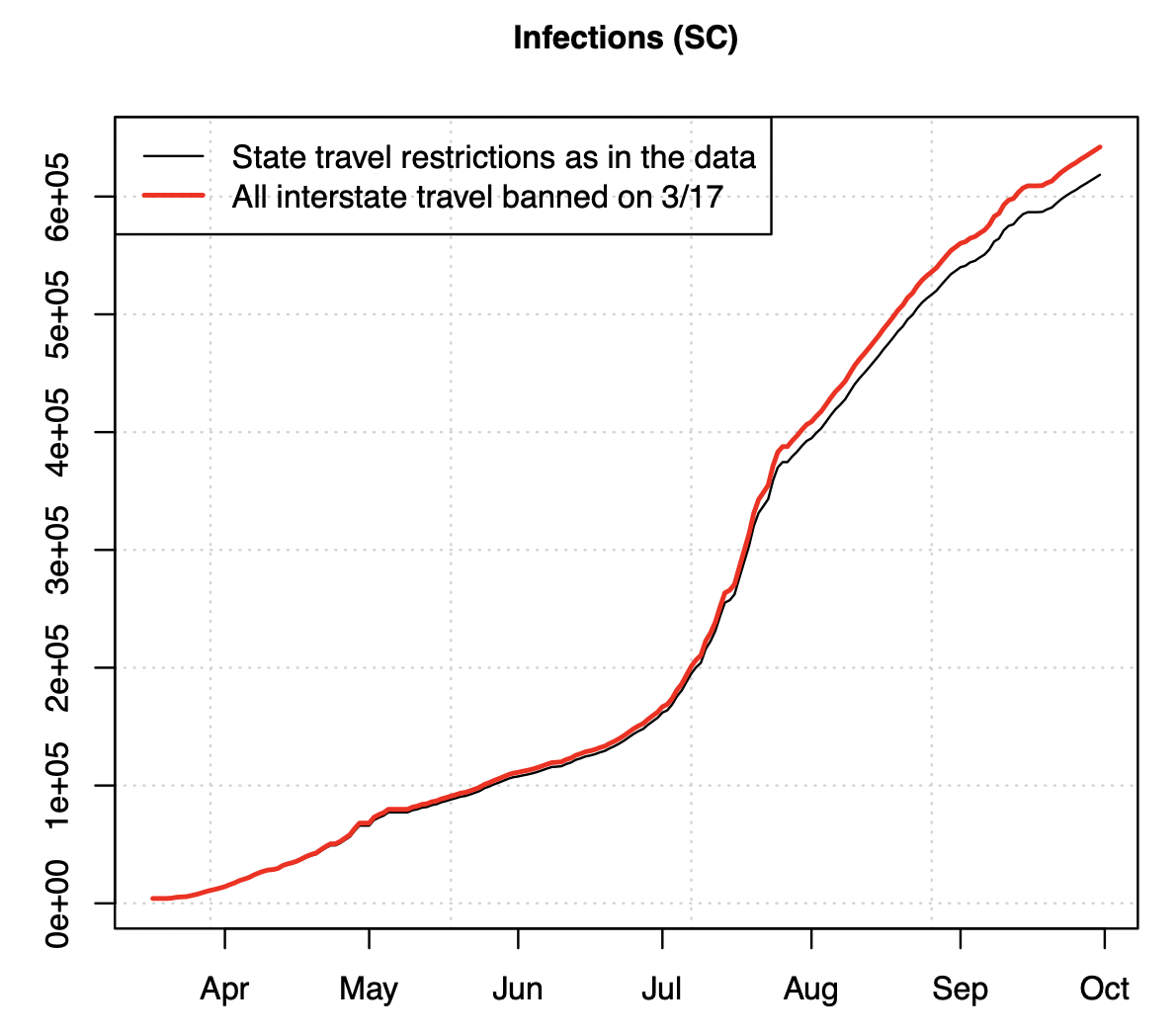The coronavirus pandemic has pushed governments to implement drastic regulatory policies to contain the disease. A large amount of research has been dedicated to studying the impact of different policies on COVID-19 infections and fatalities (Chernozhukov et al. 2020, Deb et al. 2020, Hsiang et al. 2020, and others). However, state governments in many countries can independently implement policies while others, including the federal government, do not. How effective are policies implemented in one state when other states adopt none? And what could be gained from unified federal policies?
We answer these questions in a new paper (Renne et al. 2020). Using the US as a case study, we develop a novel model of COVID-19 transmission that incorporates state and federal policy decisions, as well as interstate mobility that enables the spread of the disease (Coven et al. 2020). Our results show that while state protocols were largely effective, the lack of federal policies contributed to an accelerated spread of coronavirus nationwide. More than two-thirds of all US COVID-19 deaths could have been prevented if the federal government had required all states to adopt policies that mirrored those of the earliest-acting states. Our study highlights state and federal mask mandates as very effective tools to contain the virus. Travel bans are the least effective policies according to our study.
Data and estimates
We develop a new multi-region epidemiological model and apply it to state-level COVID-19 data from the US between 12 February and 30 September 2020. A key benefit of our approach is that it relies on death counts only. We infer how many infections there must have been to justify the trajectory of COVID-19 fatalities observed in the data given the policies that were in place and historical mobility across states.
Figure 1 shows the cumulative number of estimated infections and the estimated reproduction rate of the virus in the US. We find that there must have been more than 600 infected individuals in the US by mid-February to justify the trajectory of COVID-19 fatalities observed through 30 September. The coronavirus reproduction rate spiked at around seven by the end of February. Our estimates are up to three times higher than those of Fernández-Villaverde and Jones (2020), especially early in the sample. This suggests that the potential for infections in the US during the spring of 2020 was much higher than often assumed.1
Figure 1 Infections and the reproduction rate in the US
Notes: The top plot shows the time series of the smoothed mean of the model-implied cumulative number of COVID-19 infections, together with the number of infections in the data. The bottom plot shows the time series of the smoothed mean of the model-implied effective reproduction rate of COVID-19 in the US. The shaded areas give two-standard-deviation confidence bands. The horizontal blue line corresponds to the standard reproduction rate value of one, below which the virus does not reproduce explosively.
The impact of missing federal policies
A key question in the public policy debate is whether federal restrictions in the US could have slowed the spread of the virus (Redlener et al. 2020, Rothert 2020). We address this question by running counterfactual experiments in which we ask how many virus deaths would have been observed if the federal government had imposed policies that mirrored those of the states that adopted the earliest and strictest restrictions. We consider three types of policies: mask mandates, stay-at-home orders, and interstate travel bans.
Table 1 shows that more than 136,000 virus deaths could have been prevented if the US government had imposed early restrictions. The results indicate that more than 110,000 deaths could have been prevented had the federal government moved along with California and mandated a federal lockdown on 20 March that remained active through the sample. Close to 97,000 deaths could have been prevented if the federal government had issued a federal mask mandate as early as Connecticut did, on 17 April.
Table 1 Results of counterfactual policy experiments
Notes: The reported values are excess deaths relative to the total number of US deaths recorded in the data on 30 September 2020. In the counterfactuals, we assume that the federal regulator imposes that all states adopt a policy as soon as at least one of the states adopted that policy in the data and that the policy remains active through the end of our sample on 30 September. We also assume that a federal policy supersedes any state policy. We compute the trajectories of death counts per state under the alternative policy scenarios that are consistent with the transmission rates filtered from the observed fatalities data.
Although our results suggest that an early federal lockdown would have been most impactful, such a lockdown would arguably have carried significant economic costs (Coibion et al. 2020). Could similar outcomes have been achieved if the federal government had imposed an early mask mandate instead? Figure 2 answers this question by plotting the number of deaths that could have been prevented if a federal mask mandate had gone into effect sometime between 17 March and 17 April.
Figure 2 Impact of an early mask mandate
Notes: The horizontal axis indicates the date on which we assume a federal mask mandate had gone into effect, while the vertical axis gives the number of deaths that could have been prevented had a federal mask mandate gone into effect on that date. We assume that state-level stay-at-home and travel ban policies remain as in the data, and that a federal mask mandate supersedes the state-level mask policies.
Up to 183,000 US COVID-19 deaths could have been prevented if a federal mask mandate had gone into effect by mid-March. The large reproduction rate and number of infections in the US during the spring, highlighted in Figure 1, drive this result. Our results indicate that a key tool for a federal regulator is to issue a federal mask mandate that complements state protocols when infections and reproduction rates are high. This is an important policy lesson for future waves of the coronavirus pandemic.2
The effectiveness of state policies
Another widely debated question is whether state protocols were effective in preventing COVID-19 fatalities in the absence of federal policies (Hsiang et al. 2020, Friedson et al. 2020). To address this question, we run additional counterfactuals in which we ask: How many additional deaths would a state have observed if it had not adopted a specific policy? And how many deaths could have been prevented if a state adopted a stricter policy?
The counterfactuals show that, in the worst-case scenario in which no state had enacted any restrictions, the US would have recorded more than one million additional coronavirus fatalities. This indicates that state policies helped the US avoid a large number of COVID-19 fatalities, even in the absence of federal restrictions.
Figure 3 breaks down the number of state excess deaths if a state had either embraced all three policies or enacted no policies at all. These results show that California would have stood the most to lose by not adopting any policies: It would have recorded more than 200,000 additional coronavirus deaths if it had not imposed the restrictions it did. At the other end of the spectrum, Texas and Florida would have stood most to gain by adopting earlier and stricter policies. These states could have prevented up to 29,000 coronavirus deaths according to our study.
Figure 3 Excess deaths when a state either adopts all the policies or it adopts no policies
Notes: State-by-state breakdown of excess deaths relative to the data in the counterfactual analysis in which a state either adopts all the policies or it adopts no policies. We consider a strict scenario in which a particular state implements a policy as early as indicated in Table 1, and a loose scenario in which a state does not implement a particular policy.
Figure 3 assumes that statewide lockdowns and travel bans would have gone into effect in the different states. But it is questionable whether many state governors would have been open to imposing such policies. How would states have fared if they only imposed mask mandates without imposing stricter lockdowns or travel restrictions? Figure 4 breaks down the excess deaths that would have been observed if a mask mandate had gone into effect in a state as early as it did in Connecticut (17 April) while all other policies are kept as implemented. Many states could have prevented a significant number of COVID-19 deaths with an early mask mandate. Iowa, Nebraska, South Dakota, and Utah – the four states without any restrictions in the sample – could have prevented more than 70% of their death cases this way.3 These results highlight state mask mandates as highly effective policy alternatives to costly lockdowns and travel bans.
Figure 4 Preventable deaths through state mask mandates
Notes: State-by-state breakdown of the fraction of state virus deaths that would have been prevented had states adopted early mask mandates. We assume that a mask mandate had gone into effect on 17 April, as early as it went into effect in Connecticut.
Interstate travel bans
Several governments have restricted travel to curb the spread of coronavirus, but the impact of such policies is not well understood (Chinazzi et al. 2020, Coven et al. 2020). Our study suggests that an interstate travel ban would have led to the prevention of the smallest number of US COVID-19 deaths in Table 1. There are two reasons for this. First, travel bans were often imposed late, only once a state regulator became aware of the virus and the virus had already penetrated a state. We find that an additional 840 deaths could have been prevented if all interstate travel had been banned by 12 February, the first day of our sample.4
Second, interstate mobility scatters infections across states and this can slow down the spread of the virus. States that are net importers of travellers and commuters (such as Wyoming in the bottom panel of Figure 5) record higher numbers of infections than they would if all interstate travel were banned. In contrast, states that are net exporters of individuals (South Carolina in the top panel Figure 5) record lower numbers of infections. When interstate mobility is restricted, infected populations that would otherwise disperse out-of-state are forced to stay in-state, where they can accelerate virus transmission. We find that this effect is minor – only around 860 of the more than 110,000 virus deaths that may have been prevented by a federal lockdown in Table 1 are explained by the fact that interstate mobility is discouraged when individuals are required to stay at home.
Figure 5 Infections under the assumption that all interstate travel is banned
Notes: Time series of the smoothed mean of the model-implied cumulative number of COVID-19 infections for South Carolina and Wyoming in the data and in the counterfactual in which all interstate travel is banned on 17 March.
Our findings suggest that travel bans are only effective if they are imposed early and long enough to prevent coronavirus from taking hold in a population.
Conclusion
Viewing the US pandemic experience as a case study, we show that unified policies by state and federal regulators can be highly effective in preventing coronavirus fatalities. There are several caveats to our results. First, we do not consider whether changes in federal policies may have triggered different reactions by US states and the US population. Second, we do not consider the legality of any state or federal restrictions. Third, our results are based on a hindsight approach that assumes some information about the effectiveness of different restrictions may have already been known at the beginning of the pandemic.
Authors’ note: The codes and data used in this research are publicly available at: https://github.com/guillaume-roussellet/RRS_Covid_2020.
References
Chernozhukov, V, H Kasahara and P Schrimpf (2020), “Causal impact of masks, policies, behavior on early covid-19 pandemic in the U.S.”, Journal of Econometrics, forthcoming.
Chinazzi, M, J Davis, M Ajelli et al. (2020), “The effect of travel restrictions on the spread of the 2019 novel coronavirus (COVID-19) outbreak”, Science 368(6489): 395–400.
Coibion, O, Y Gorodnichenko and M Weber (2020), “The Cost of the Covid-19 Crisis: Lockdowns, Macroeconomic Expectations, and Consumer Spending”, NBER Working Papers 27141.
Coven, J, A Gupta and I Yao (2020), “Urban Flight Seeded the COVID-19 Pandemic Across the United States”, Covid Economics 54: 121–157.
Deb, P, D Furceri, J Ostry and N Tawk (2020), “The Effects of Containment Measures on the COVID-19 Pandemic”, Covid Economics 19: 53–86.
Fernández-Villaverde, J and C I Jones (2020), “Estimating and Simulating a SIRD Model of COVID-19 for Many Countries, States, and Cities”, NBER Working Papers 27128.
Friedson, A I, D McNichols, J J Sabia and D Dave (2020), “Did California’s Shelter-in-Place Order Work? Early Coronavirus-Related Public Health Effects”, NBER Working Papers 26992.
Hsiang, S, D Allen, S Annan-Phan et al. (2020), “The effect of large-scale anti-contagion policies on the COVID-19 pandemic”, Nature 584: 262–267.
Karaivanov, A, S Lu and H Shigeoka (2020), “Face mask mandates slowed the spread of COVID-19 in Canada”, VoxEU.org, 5 June.
Redlener, I, J D Sachs, S Hansen and N Hupert (2020), “130,000 – 210,000 Avoidable COVID-19 Deaths – And Counting – In The U.S.”, Working Paper, Columbia University.
Renne, J P, G Roussellet and G Schwenkler (2020), “Preventing COVID-19 Fatalities: State versus Federal Policies”, Covid Economics 56: 106–156.
Rothert, J (2020), “Optimal Federal Redistribution During the Uncoordinated Response to a Pandemic”, United States Naval Academy Working Papers 64.
Stutt, R, R Retkute, M Bradley, C Gilligan and J Colvin (2020), “A Modelling Framework to Assess the Likely Effectiveness of Facemasks in Combination with ‘Lock-down’ in Managing the COVID-19 Pandemic”, Proceedings of the Royal Society A: Mathematical, Physical and Engineering Sciences 476(2238): 20200376.
Endnotes
1 There are several reasons for the differences in our estimates and those of Fernández-Villaverde and Jones (2020). First, we assume that the virus is less deadly than did Fernández-Villaverde and Jones (2020). Second, we assume that infected individuals are infectious for 14 days, while Fernández-Villaverde and Jones assume that individuals are infectious for five days. These differing assumptions explain most of the differences in our estimates. Third, our reproduction rates are smoothed given all available data, while those of Fernández-Villaverde and Jones are filtered given the concurrently available data. Our estimates of what the reproduction rate must have been early in the sample take into account the trajectory of death cases that were observed later in the sample, while those of Fernández-Villaverde and Jones do not.
2 Similar policy recommendations in support of federal mask mandates are given by Chernozhukov et al. (2020), Karaivanov et al. (2020), Stutt et al (2020), and others.
3 Since our study was finalised, Iowa and Utah have enacted state mask mandates.
4 Coven et al. (2020) also argue that an early ban of interstate travel could have prevented COVID-19 deaths as it would have averted an urban flight phenomenon.
5 A new approach to control for these kinds of effects has recently been proposed by Chernozhukov et al. (2020).














